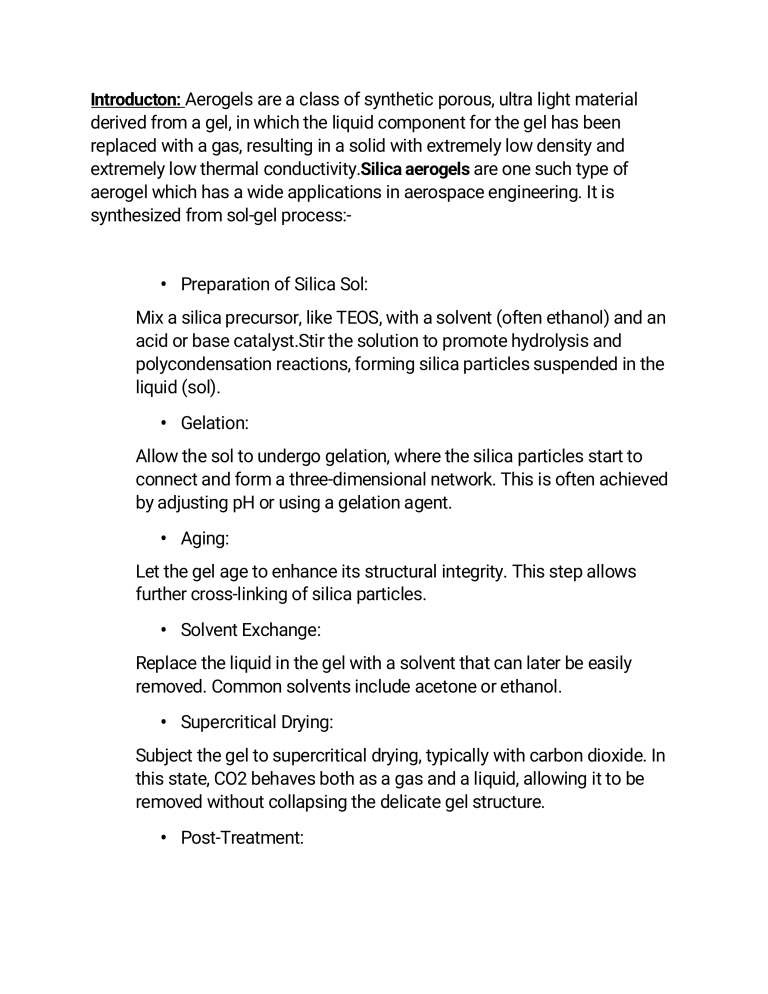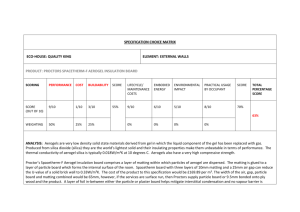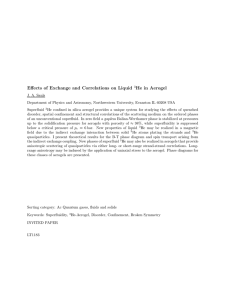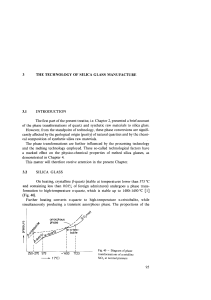
Introducton: Aerogels are a class of synthetic porous, ultra light material derived from a gel, in which the liquid component for the gel has been replaced with a gas, resulting in a solid with extremely low density and extremely low thermal conductivity.Silica aerogels are one such type of aerogel which has a wide applications in aerospace engineering. It is synthesized from sol-gel process:- • Preparation of Silica Sol: Mix a silica precursor, like TEOS, with a solvent (often ethanol) and an acid or base catalyst.Stir the solution to promote hydrolysis and polycondensation reactions, forming silica particles suspended in the liquid (sol). • Gelation: Allow the sol to undergo gelation, where the silica particles start to connect and form a three-dimensional network. This is often achieved by adjusting pH or using a gelation agent. • Aging: Let the gel age to enhance its structural integrity. This step allows further cross-linking of silica particles. • Solvent Exchange: Replace the liquid in the gel with a solvent that can later be easily removed. Common solvents include acetone or ethanol. • Supercritical Drying: Subject the gel to supercritical drying, typically with carbon dioxide. In this state, CO2 behaves both as a gas and a liquid, allowing it to be removed without collapsing the delicate gel structure. • Post-Treatment: Optionally, perform post-treatment steps to modify the aerogel's properties. This may include surface modification or impregnation with other substances Silica Aerogel application in Aerospace engineering:- Thermal Insulation :NASA extended its research on aerogel in the field of thermal insulation because of its extremely low conductivity. Silica aerogel was firstly used as an insulator on the Mars Rover, Sojourner, as part of the Pathfinder mis- sion in 1997. The aerogel was packed in composite boxes, called Warm Electronics Boxes (WEBs), to protect the primary battery pack of the Alpha Particle X-Ray Spectrometer (APXS) from extremely low temperatures. The operational range of the battery was set to be between −40∘ C to +40∘ C each day with a limit of +55∘ C for not more than five hours. A value of 21∘ C was successfully achieved [145]. Being effi- cacious, aerogel was chosen again in the Mars Exploration Rovers, Spirit and Opportunity in 2003. Additional devices were installed in these robots, for example, Radioisotope Heater Units (RHUs) which would induce extra heat [146]. To avoid heat dissipation, aerogel was placed as a barrier to sus- tain a temperature variation of up to 100∘ C between the Martial day and night when the temperature is approximately +20∘ C and −99∘ C, respectively. To increase the performance of the silica aerogel as an insulator, it composition was modified by doping graphite with necessary alteration in the drying process to ensure no cracking and shrinking Fire Retardation:Fire Retardation. The fact of being an inorganic and inflammable material with a continuous operating tempera-ture ranging from −273 C to 650C and a high melting point of 1400C makes silica aerogel an excellent firewall compared to the existing combustible organic coatings that cause toxic fumes when burning. The components such as pipes, wires, and electronic accessories within the fire zones of an aeroengine can be protected using thin blankets of aerogel whilst simultaneously enabling weight saving compared to conven- tional metal sheets. Similarly, the adjacent airframe structures will be prevented from being burnt. Aspen Aerogels has investigated on such applications where the insulation blanket made of silica aerogel with a thickness of 7 mm was exposed to a flame at temperature 1100∘ C for at least 15 minutes (see Figures 7(a) and 7(b)). The temperature on the cold side did not exceed 150C. Thermal Barrier :The justification of considering silica aerogel as a thermal barrier is due to its favorable characteris- tics in operating temperatures, longevity, chemical (aviation fuels and lubricants) and erosion resistance, and mainte- nance. A simpler and lighter overall design of the thermal insulation system can be achieved which will consequently reduce the assembly cost as fewer materials are needed. More space will be available for other usages. There will be a rise in the energy efficiency because of the minimization of heat loss and hence fuel will be saved. That is, the direct operating cost will also decrease. Considering, an aeroengine, silica aerogel can be applied in two modes, depending on the temperature and environment requirements. Firstly, it could be sprayed as a thin insulative coating to protect unattainable and uneven substrate from high temperatures. The smooth and uniform layer of insulation will cause little resistance to the airflow. The thermal responses will be improved which will in turn increase the performance of the engine while the aircraft is cruising at high altitude. Secondly, in compartments where the vibration is high, flexible light-weight blankets of silica aerogel with custom thickness can be used. They can be fastened mechanically to prevent any displacing hence inter- ferences problems. Contrary to coatings, blankets are more resistant to contaminations and do not disintegrate easily. Their maintenance cost is also lower than that of coatings. Cost analysis and Market trend:- The production of silica aerogels can be expensive due to the specialized processes involved, which may limit their adoption in cost-sensitive applications. The silica aerogel market is global, with significant growth in North America, Europe, and Asia. North America, driven by technological advancements and a focus on sustainability, has seen substantial growth in silica aerogel applications in aerospace, construction, and oil and gas industries. Europe, with its stringent environmental regulations, is also a prominent market for silica aerogels. In Asia, rapid industrialization and increasing infrastructure development are fueling demand for this materia Future prospects:- The silica aerogel market is expected to continue its growth trajectory, driven by the demand for energy-efficient and sustainable solutions across industries. Ongoing research and development efforts are focused on improving the cost-effectiveness and durability of silica aerogels, which will further expand their applications. As industries and governments increasingly prioritize energy efficiency and sustainability, silica aerogels are poised to play a pivotal role in meeting these demands, making them a vital component of future technological and industrial advancements




